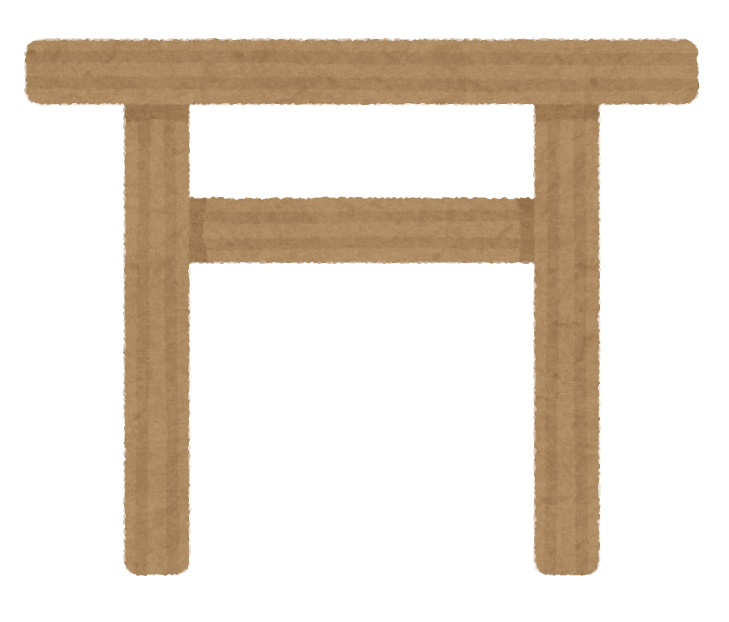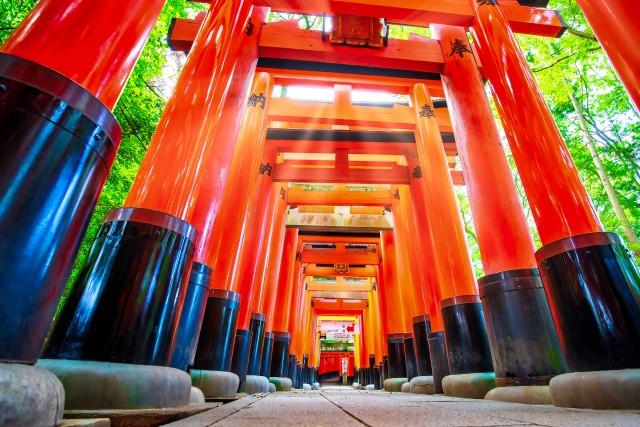You’ve probably seen Torii in photos of Japan without realising what they actually are. Torii are the entrance gateways to Shinto shrines. Not only are they beautiful to behold, they carry great significance to Shinto shrines. Learn more about Torii, from their origins to most remarkable ones to see.
Table of Contents
- Introducing Shinto Gates, Torii
- Different Styles of Torii
- Famous Sites with Remarkable Torii
- Takeaway
Introducing Shinto Gates, Torii

What are Torii?
Torii 鳥居 are traditional entrance gates leading to Shinto shrines. They are also frequently used to denote power spots, places people say they can get power or energy. Torii are easily recognizable because of their sheer size and bright redness which is said to grant protection from evil (though not every torii is large and red). One shrine may have not just one but several Torii. Another reason for the redness is that red paint contains a substance that protects the wood from deterioration.
Where did Torii come from?

There is no clear evidence as to the origins of Torii. Some say they were brought over along with Buddhism from China, others note their similarity to India’s Torana gates. There are other similar structures as well in other parts of Asia, not to mention the possible theory that they are an original Shinto structure.
This last theory suggests that Shintosim is an indeginious religion. To mark holy ground, or kami (god) dwelling, the believers of Shintoism would construct a simple Torii with posts tied together. In time, as civilization progressed, more complicated buildings like Shinto shrines were built and the basic Torii structure evolved to look more majestic.
What is the significance of Torii in Shintoism?
Torii are not just elaborate structures made to look pretty. A Torii’s greatest role is to divide the sacred Shinto grounds from the mundane world. The vermillion colour of the Torii, as stated earlier, also acts as protection against evil and provides blessings of vitality.
※ Encyclopædia Britannica, Inc., "Shintō"
Are there any customs or manners in entering a Torii?
Yes, there are. You should abide by two things walking through a Torii:
-
Bow a little before entering; and
-
Do not enter from the centre, but instead approach from the side. It is believed that the centre is reserved for kami.
Writer's Pick
Different Styles of Torii
Did you know there are different Torii designs?
There are two main styles of Torii, followed by their sub-styles and unique designs.
Myojin Torii

A more complex form made to look grand with a curved lintel.
Shinmei Torii

The simplest form with straight columns, lintel, and beam.
Famous Sites with Remarkable Torii

Fushimi Inari Taisha
Fushimi Inari Taisha in Kyoto has approximately 10,000 torii gates. They come in various sizes forming a path for visitors to follow to the shrine entrance. The reason for the large number of torii gates is that they are a form of offering to the shrine deities or an act of gratitude for the granting of prayers. From 210,000 yen, anyone can make an offering via torii. The donor’s name and date of donation will be inscribed on the torii.
※ Fushimi Inari Taisha, "FAQ" “Guide to Torii Offering”
For more about Fushimi Inari Taisha, check our dedicated article:
Walking down one Thousand Torii for Prosperity: a guide of Fushimi Inari Taisha

Itsukushima Shrine
Itsukushima Shrine in Miyagi Prefecture is famous for its “floating on water” Torii. Aside from being a World Heritage site along with Itsukushima Island, 6 of the shrine buildings are designated National Treasures of Japan. The picturesque sight of the vermillion shrine floating on the ocean surface during high tide is one that will forever be engraved in your memory. Though less impressive during low tide, you can approach the torii itself to have a closer look.
Read more in our article - A look in to the home of Miyajima Torii: Itsukushima Shrine
※ UNESCO, “Itsukushima Shinto Shrine”

Shirahige Jinja
Shirahige Jinja in Shiga Prefecture has a beautiful torii floating on Lake Biwa’s surface. It is no less beautiful than Itsukushima Shrine though not as well known, with a divine atmosphere as it “floats” on the calm silent lake. Beautiful against the stark blue of the sky and ocean, you can also visit during sunrise for a brilliant scene of the sun captured between the gates.
For more things to do in Shiga Prefecture:
Best Places and Hidden Treasures of Shiga Prefecture
※ SHIGA Tourism Official Website, “Shirahige-jinja Shrine”

Sakurai Shrine
Sakurai Shrine in Fukuoka Prefecture has an ivory white torii overlooking the blue ocean. The torii can be found at Sakurai Futamigaura, a beach in Itogashima City. Near the torii amidst the ocean waters is a “couple of rocks'' called Fuufu Rocks (夫婦岩) - fuufu means husband and wife. They are joined together (in holy matrimony) by shimenawa, a straw rope frequently seen in Shinto shrines or upon torii. It is believed in ancient times that these rocks show the entrance to Ryugu 竜宮, the underwater dragon palace.
※ Itogashima City Official Website, “Sakurai Futamigaura”

Meiji Jingu
Meiji Jingu in Tokyo has two magnificent and large wooden torii. At 12 metres tall, these torii are not the usual vermillion red nor white, instead retaining its wooden brown. This shrine is dedicated to Emperor Meiji and Empress Shoken who led the modernization of Japan through the Meiji Restoration. The shrine complex is vast, including even a forest. Meiji Jingu is one of the best places to enjoy autumn foliage in Japan.
Takeaway

Torii is one of Japan's icons and a symbol of Shintoism. Serving as a divider, it creates a boundary between our ordinary realm and the kami’s sacred lands. Aside from its great religious and cultural significance, it also serves as proof of religious development in Japan, with a bonus of being beautiful and adding to the serenity of shrines. Aside from the famous Torii gates mentioned above, there are many more across Japan that you need only look for. From mysterious ones hidden in caves (Amano Iwato Jinja) to winding dragon-like ones leading down to a seaside cliff (Motonosumi Inari Shrine), there’s many beautiful torii to be found in Japan.


































